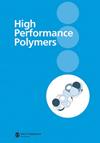Modification of bisphenol a type epoxy resin by biobased magnolol epoxy
IF 1.6
4区 化学
Q3 POLYMER SCIENCE
引用次数: 0
Abstract
Reducing the dependence of epoxy resin preparation on petroleum resources and developing thermosetting epoxy resins with excellent comprehensive performance are important directions for the current development of epoxy resins. This article uses biomass resource magnolol as the main raw material to prepare magnolol epoxy monomer (DGEM). Then, using 4,4-diaminodiphenylmethane (DDM) as the curing agent, the DGEM and bisphenol A epoxy resin (E44) were blended and cured. The results showed a dual modification effect of DGEM on the toughening and strengthening of E44 epoxy resin. When the mass ratio of DGEM to E44 is 30:70, the bending strength of the cured blended resin is 18.7% higher than that of the E44 system, and the tensile strength is 57.7% higher. When the mass ratio of DGEM to E44 is 5:95, the cured blended resin exhibits the optimal impact strength (5.10 kJ/mol), which is 22.9% higher than the pure E44 system. However, the addition of DGEM reduced the glass transition temperature and crosslinking degree of the blended resin system. The addition of DGEM improves the heat resistance and flame retardancy of the blended resin. When the mass ratio of DGEM: E44 was 50:50, the vertical combustion reached UL-94 V-0 level.用生物基环氧木兰醇改性双酚 A 型环氧树脂
减少环氧树脂制备对石油资源的依赖,开发综合性能优异的热固性环氧树脂,是当前环氧树脂发展的重要方向。本文以生物质资源木兰醇为主要原料,制备了木兰醇环氧单体(DGEM)。然后以 4,4-二氨基二苯甲烷(DDM)为固化剂,将 DGEM 与双酚 A 环氧树脂(E44)混合固化。结果表明,DGEM 对 E44 环氧树脂具有增韧和增强的双重改性效果。当 DGEM 与 E44 的质量比为 30:70 时,固化混合树脂的弯曲强度比 E44 体系的弯曲强度高 18.7%,拉伸强度高 57.7%。当 DGEM 与 E44 的质量比为 5:95 时,固化混合树脂显示出最佳冲击强度(5.10 kJ/mol),比纯 E44 体系高出 22.9%。然而,DGEM 的添加降低了共混树脂体系的玻璃化转变温度和交联度。DGEM 的添加提高了共混树脂的耐热性和阻燃性。当 DGEM 与 E44 的质量比为 50:50 时,垂直燃烧达到了 UL-94 V-0 级。
本文章由计算机程序翻译,如有差异,请以英文原文为准。
求助全文
约1分钟内获得全文
求助全文
来源期刊

High Performance Polymers
化学-高分子科学
CiteScore
4.20
自引率
14.30%
发文量
106
审稿时长
1.2 months
期刊介绍:
Health Services Management Research (HSMR) is an authoritative international peer-reviewed journal which publishes theoretically and empirically rigorous research on questions of enduring interest to health-care organizations and systems throughout the world. Examining the real issues confronting health services management, it provides an independent view and cutting edge evidence-based research to guide policy-making and management decision-making. HSMR aims to be a forum serving an international community of academics and researchers on the one hand and healthcare managers, executives, policymakers and clinicians and all health professionals on the other. HSMR wants to make a substantial contribution to both research and managerial practice, with particular emphasis placed on publishing studies which offer actionable findings and on promoting knowledge mobilisation toward theoretical advances. All papers are expected to be of interest and relevance to an international audience. HSMR aims at enhance communication between academics and practitioners concerned with developing, implementing, and analysing health management issues, reforms and innovations primarily in European health systems and in all countries with developed health systems. Papers can report research undertaken in a single country, but they need to locate and explain their findings in an international context, and in international literature.
文献相关原料
公司名称
产品信息
阿拉丁
4,4-diaminodiphenylmethane (DDM)
阿拉丁
Benzyltriethylammonium chloride
 求助内容:
求助内容: 应助结果提醒方式:
应助结果提醒方式:


